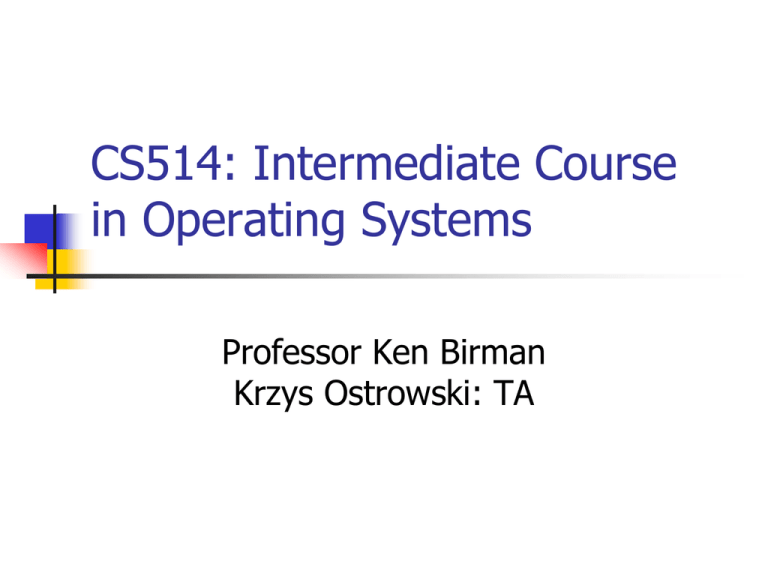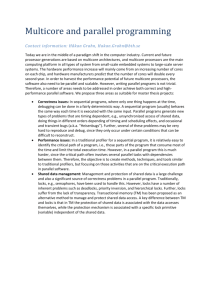CS514: Intermediate Course in Operating Systems Professor Ken Birman Krzys Ostrowski: TA
advertisement

CS514: Intermediate Course
in Operating Systems
Professor Ken Birman
Krzys Ostrowski: TA
Today
Multicore!
Hardware trends
Issues in taking advantage of multicore
Can we adapt transactional constructs to
make it easier to program multicore
machines?
What other options exist for exploiting
multicore platforms
Underlying trends
Moore’s law is reaching its end
Underlying issue is heat dissipation
Power rises as the square of clock rate
Double the speed… Produce 4 times the heat!
Faster chips need smaller logic and faster
clocks: a recipe for melt-down
And this has (literally) begun to occur!
Wikipedia
What can we do?
Give up on speed
Not such a silly proposition: Speed isn’t
necessarily the only thing that matters
But in practice, faster machines have
driven most technical advances of the past
few decades, so this is a risky bet!
Or find some other way to gain speed
… like parallelism!
Forms of parallelism
We’ve talked at length about ways of
replicating data within pools of servers
This lets the server group handle huge
request rates, a form of “embarrassing
parallelism”
Ultimately, limited by the rate at which we
can update the state shared by the servers
Parallelism is “embarrassing” if the
tasks to be done have no conflicts
Transactional databases
ACID was all about a form of
interleaved parallelism
We build a server, but it spends lots of
time idle (waiting for disks to spin)
So we create a model for interleaving
operations from distinct transactions to
exploit the idle time (but without breaking
the logic of the code)
This works well… for databases
Transactional databases
But remember Jim Gray’s RAPS/RACS?
He basically argued that the only way to
scale up a database is to partition it!
Experience has been that exploiting more
than 4 processors is incredibly tough
And we just saw how hard it can be
even to replicate a database.
Back to hardware
The big new thing is “multicore”
Put multiple CPUs on a single chip
They have independent CPU and FPUs
Each basically runs a distinct thread
They share the level-2 cache
Intel will deliver 100-core processors
within a few years!
Why is this beneficial?
Recall our “double the speed, four times the
heat” concern?
Suppose we decide to use four times the power
with multicore?
We get four times the speed, potentially!
Better “price performance” story
With a 100-core chip, we get 100x
performance but the same power as a chip
10x faster.
Our challenge?
How to take advantage of these
multicore machines?
Can we just run embarrassingly parallel
tasks?
Yes, to some degree
We could dedicate a few cores to graphics, disk
I/O, running network protocols, etc.
But this will still only use up a couple of them
What will we do with the rest?
Divergent visions
Ken’s goal: Live Objects on multicore
Thinking is that end-user “expresses” an
embarrassingly parallel application when
she drags and drops content
Seems like a great match for multicore
For this sort of application, key issue is
to ensure that the LO platform itself
doesn’t have too much synchronization
Quicksilver
System supports lots of groups…
… but in fact, we had to build it as a
single thread to push performance as
high as possible!
Issue was related to scheduling problems
Without controlling scheduling, Quicksilver
sometimes ended up delaying high-priority
tasks and doing them “late”
How about… Web Services?
Most of them are multithreaded (recall
our discussion of SEDA?)
The holy grail of the multicore
community is to take some random
compute-intensive application and
magically be able to exploit multicore!
One idea: just assign each thread to a
different core
Experience?
This is harder than it sounds
Many applications crash if you do that:
bugs were “latent” in the code
Same issue mentioned with Oracle occurs:
one often sees speedup with perhaps 4
processors but then things slow down
Issue revolves around thread contention
Issues that arise
Threads synchronize using locking or
the Java “synchronized” construct
(which automates locking)
Surprisingly hard to use
Known source of a great many bugs
Locking (which can deschedule a thread)
triggers all sorts of overheads
Threads are hard to use!
… as anyone who takes the Cornell
CS414 class will learn
Need to deal with race conditions,
deadlock, livelock, resource contention
If you use a lot of threads, even briefly,
your program may thrash
If your threads aren’t careful they can
overflow the (bounded size) stack area
Easy to make mistakes
Class foo {
int add (bar x, bar y) {
Designer
probably
wanted
Class bar
{
public
int v;
this to be
atomic,
but it isn’t!
synchronize (this) {
static public int swap (bar x, bar y) {
int z = x.v+y.v;
static boolean lock;
}
synchronize (lock) {
return(z);
bar tmp = x;
}
x = y;
}
y = tmp;
}
}
}
Transactions: The holy grail?
Languages community has begun to
think about revisiting transactional
languages as a way to make multicore
easier to exploit
Thinking is that by offering shortrunning transactional constructs we can
implement non-blocking threaded apps
What does “non-blocking” mean?
Traditional locks are blocking
The caller either gets the lock and can
continue, or pauses, is descheduled, and
will only be run again once lock is released
Costs?
Scheduling (twice)
Flush the TLB
Loss of processor affinity
What does “non-blocking” mean?
A non-blocking synchronization scheme
typically uses “busy waiting” loops
Thread A wants lock X, but lock X is in use
… so A loops, repeatedly checking X
Idea is that A is continuously running and
hence ready to go the instant X is unlocked
Comes down to “how to implement locks”
and similar constructs
Non-blocking synchronization
Typically revolves around a special
instruction provided by the chip
Compare and Swap: most powerful
Test and Set: weaker but can implement
locks
Others may be too weak to do locking
First option: Non-blocking locks
For example, using test and set
Boolean lock x = false;
Lock(lock x) {
while(test_and_set(x) != false)
continue;
}
Unlock(lock x) {
x = false;
}
Issues?
On the positive side, a great match with
Java or C# synchronization
But we were reminded earlier that
those both are tricky to use correctly
Non-blocking data structures
Much research has been done on
building data structures that use classspecific synchronization for speed
E.g. non-blocking trees, queues, lists
Again, these DO wait… they just don’t
deschedule the thread that needs to loop
Leads to per-structure analysis and tuning
Transactions
Here, concept is to revisit ideas from
Argus but now do it with in-memory
data structures
Basically, transactions directly on Java
classes, offering begin/commit/abort in the
language itself
Hardware could provide support
Herlihy: Obstruction Free sync.
Maurice Herlihy has developed a new
theory of “obstruction free” computing
He uses it to develop new kinds of
hardware and to prove that the hardware
correctly implements transactions
Sun has a special transactional hardware
accelerator based on this model
Key concepts?
Sun hardware works this way:
Any thread can read any object without telling
other threads, but must keep track of what it read
To write, threads do check for other concurrent
writes; they contend for a form of lock
At commit, we confirm that the writes are
serializable and that the values read are still valid
(haven’t been overwritten by some other
transaction). Hardware does this test for us
Pros and cons
This kind of hardware assist works well
if certain properties hold:
Transactions need to be very short. Not
appropriate for nested transactions or
long-running tasks
Transactional conflicts need to be very
rare. Not useful otherwise
May argue for a mix of locks and
transactional tools
What about locking?
Performance impact is dramatic if locks
are held long and thread contention
arises, so this is known to be an issue
But with short-lived locks and little
contention, performance can be great
(better than existing transactional
memory options)
Better hardware may help
Other current work?
Compiler developers are exploring
options for discovering exploitable
parallelism through static analysis
Seeing that an application calls f() and g(),
analysis might discover that both can run
in parallel
Then would spawn new threads
Issue: this analysis is very difficult
Other current work?
Some interest in new languages
Language would be inherently parallel,
much as in the case of Live Objects
Compiler could them spit out code that
automatically exploits multicore
Encouraging results for signal processing
applications, but not so clear in other uses
(issue: most people prefer Java!)
Other multicore scenarios?
Many big companies are focused on
multicore in datacenter settings
Basically, a chance to save a lot of power
and money
Good news: these guys are mostly porting
applications one by one, and that means
lots of work for developers like you!
Quick summary
Multicore: Clearly the hot new thing
Much potential for speedups
Also can save a lot of power
Big need is for ways to help users exploit the
power
Embarrassing parallelism is especially promising,
because it may be common
Industry is betting on transactional memory but
the challenge is really significant

